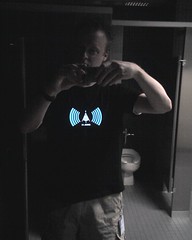 During my recent trip to MIT I met with Andrew Lippman, an Associate Director at the MIT Media Lab and a Senior Research Scientist. Lippman heads up the Lab's Viral Communications program, which "examines scalable, real-time networks whose capacity increases with the number of members." Among other things, we discussed an interesting new product his students are working on called Fluid Voice. In a way it works similar to how CB radio did for truck drivers in the 1970s - providing a mobile group communication system.
During my recent trip to MIT I met with Andrew Lippman, an Associate Director at the MIT Media Lab and a Senior Research Scientist. Lippman heads up the Lab's Viral Communications program, which "examines scalable, real-time networks whose capacity increases with the number of members." Among other things, we discussed an interesting new product his students are working on called Fluid Voice. In a way it works similar to how CB radio did for truck drivers in the 1970s - providing a mobile group communication system.
Re-Thinking Communications
First a little background. Lippman explained that his Viral Communications group aims to "symmetricize media" - in other words, balance it. He used an analogy of the radio system. The power to broadcast over the radio is still tightly controlled, spectrum is limited. So in that sense it is asymmetrical, unbalanced. The MIT Viral Communications group aims to re-think the way media works. Lippman and his group is asking: does radio have to be like this?
 Lippman explained this in an executive summary a while back:
Lippman explained this in an executive summary a while back:
"The communication industry is in an upheaval equivalent to that caused by the advent of personal computers in the early 1980's. In that earlier revolution, traditional giants who held to mainframe technologies and centralized services were outpaced by newcomers with new ideas about individual ownership, incremental adoption and instant turnover. This will now happen with communications."
Examples of new forms of communications are sensors and open 802.11 networks, which are "renegades: unlicensed, personalized, digital, and embedded." [the guy in the glowing 802.11 detector shirt to your right is not Andrew Lippman btw]
This all brings about new types of social interactions with media, which Lippman seems particularly keen on right now. He mentioned the intersection with mobility: "It's not about you anymore, it's about you plus your context."
Fluid Voice: A Mobile Group Communication System
The theory of viral communications is a bit hard for the layman (this writer included) to grok, so I asked Lippman for some examples. One of his group's projects is Fluid Voice, a research project that has been prototyped on the Nokia N810. It runs, initially at least, using the 802.11s wireless mesh.

Fluid Voice is described in a white paper as "a proximity based mobile group communication system for opportunistic social exchanges." This makes one think of a mobile app for picking up members of the opposite sex. But being an academic project, I'm sure that's not the point of it. So what is it? Lippman described Fluid Voice to me as a new type of messaging system that engages a group. He said that it's like a telephone system that defaults to a conference call all of the time, which he termed "push to listen." It has similarities to party-line telephone systems, instant messaging chat rooms and conferencing bridges for business people. It's also like the Citizen's Band (CB) radios used by truck drivers in the 1970s.
Fluid Voice can be both a live and asynchronous experience - i.e. you don't need to be participating live to receive and leave messages. It isn't just audio and text messaging either: audio polls and wish lists are a part of the product. Here is a UI screenshot:

Fluid Voice Use Cases
The goal of Fluid Voice is to coordinate people in outdoor settings, using their mobile phones. According to a white paper, use cases include "spreading news during emergency responses and supporting impromptu social exchanges."
The name of the product, Fluid Voice, derives from the fact that "users can transition from live to asynchronous audio communication in a fluid manner depending on the wireless environment." To appreciate what this kind of system might be used to enable, here's a description from the paper of how CB radio was used in the 70's:
"CB radios enabled a cooperative social culture on the highways for friendly conversations in addition to providing road assistance and accident prevention among the drivers. As cell phones and multi-band WiFi enabled cell phones are becoming ubiquitous in the 21st century, an exciting opportunity arises for supporting opportunistic social collaboration within a local area."
One imagines that software like this may become a common feature in next generation mobile phones. I used the example of a sensor-enabled bookstore in this week's post about Cross Reality applications - the store pinging your mobile phone about a book on your wish list that it happens to have in stock. We can similarly forsee that Fluid Voice, on your mobile phone, could be used to meet like-minded people at the bookstore. You could even continue to chat with that group after you left the bookstore.
Social networking 3.0 anyone? Breaker 1-9!
Image credits: get directly down; slworking2
No comments:
Post a Comment